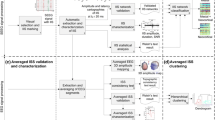Summary
In dipole localization analysis many problems remain which affect the accuracy of localization. We performed dipole estimation of spikes and SEP components in identical patients. The subjects are 8 cases of benign childhood epilepsy with centrotemporal spikes (BCECS), and two cases of temporal lobe epilepsy (TLE). In 8 of 10 cases, we also investigated dipoles using a 3-layer model in addition to a single layer (homogenous) model. Results: 1) In 8 cases of BCECS, the spike dipoles were concentrated at the central line near the SEP dipoles, at a slightly fronto-lateral-downward position to the latter. The spike dipoles seemed to be situated at the bottom of the sensory cortex. 2) In two cases of TLE, the spike dipoles were located at the same coronal plane with the SEP dipoles, and more deeply seated mesially. The spike dipoles seemed to be at the bottom of the mesial temporal area. 3) Using 3-layer models, both the spike dipoles and the SEP dipoles located more superficially, while conserving the positional relationship with each other. Conclusion: It is possible to more accurately define spike dipoles by using the SEP dipole as a marker.
Similar content being viewed by others
References
Beaussart, M. Benign epilepsy of children with rolandic (centro-temporal) paroxysmal foci. Epilepsia, 1972, 13:795–811.
Chiappa, K.H., Choi, S.K. and Young, R.R. Short-latency somatosensory evoked potentials following median nerve stimulation in patients with neurological lesions. In: J.E. Desmedt (Ed.), Clinical Uses of Cerebral, Brainstem and Spinal Somatosensory Evoked Potentials. Prog. Clin. Neurophysiol., Basel, Karger, 1980, 7:264–281.
Cohen, D., Cuffin, B.N., Yonokuchi, K., Maniewski, R., Purcell, C., Cosgrove, G.R., Ives, J., Kennedy, J.G. and Schomer, D.L. MEG versus EEG localization test using implanted sources in the human brain. Ann. Neurol., 1990, 28:811–817.
Commission on Classification and Terminology of the International League against Epilepsy. Proposal for revised classification of epilepsies and epileptic syndromes. Epilepsia, 1989, 30(4): 389–399.
Desmedt, J.E. and Cheron, G. Non-cephalic reference recording of early somatosensoty potentials to finger stimulation in adult or aging normal man: Differentialtion of widespread N18 and contralateral N20 from the prerolandic P22 and N30 components. Electroenceph. Clin. Neuphysiol., 1983, 56: 635–651.
Fender, D.H. Source localization of brain electrical activity. In: A.S. Gevins and A. Remond (Eds.), Method of analysis of brain electrical and magnetic signals, EEG Handbook (Revised Series, Vol. 1) Elsevier Science Publishers B.v., 1990, 1: 355–403.
Homma, S., Musha, T., Nakajima, Y., Okamoto, Y., Biom, S., Flink, R., Hagbarth, K.E., and Moström, U. Location of electric current sources in the human brain estimated by the dipole tracing method of the SSB (Scalp-Skull-Brain) head model. Electroenceph. Clin. Neurophysiol., 1994, 91: 374–382.
Jayakar, P., Duchowny, M., Resnick, T.J. and Alvarez, L.A. Localization of seizure foci: Pitfalls and Caveats. Journal of Clin. Neurophysiol., 1991, 8(4): 414–431.
Musha, T. and Homma, S. Do optimal dipoles obtained by dipole tracing method always suggest true source locations? Brain Topography, 1990, 3(1): 143–150.
Nuwer, M.R., Banoczi, W.R., Cloughesy, T.F., Hoch, D.B., Peacock, W., Levesque, M.F., Black, K.L., Martin, N.A. and Becker, D.P. Topographic mapping of somatosensory evoked potentials helps identify motor cortex more quickly in the operating room. Brain Topography, 1992, 5(1): 53–57.
Pateau, R., Hämäläinen, M., Hari, R., Kajola, M., Karhu, J., Larsen, T.A., Lindahl E. and Salonen O. Magnetoen-cephalographic evaluation of children and adolescents with intractable epilepsy. Epilepsia, 1994, 35(2): 275–284.
Roth, B.J., Balish, M., Gorbach, A. and Sato, S. How well does a three-sphere model predict positions of dipoles in a realistically shaped head? Electroenceph. Clin. Neurophysiol., 1993, 87: 175–184.
Schneider, M. Effect of inhomogeneities on surface signals coming from a cerebral current-dipole source. IEEE Trans. Biomed. Eng., 1974, BME-21: 52–54.
Smith, D.B., Sidman, R.D., Flanigin, H., Henke, J. and Labiner, D. A realiable method for localizing deep intracranial sources of the EEG. Neurology, 1985, 35: 1702–1707.
Suthering, W.W., Crandall, M.D., Darcey, T.M., Becker, D.R., Levesque, M.F. and Barth, D.S. The magnetic and electric fields agree with intracranial localizations of somatosensory cortex. Neurology, 1988, 38: 1705–1714.
van der Meij, W., Wieneke, G.H. and van Huffelen, A.C. Dipole source analysis of rolandic spikes in benign rolandic epilepsy and other clinical syndromes. Brain Topography, 1993, 5(3): 203–213.
Weinberg, H., Brickett, P., Coolsman, F. and Baff, M. Magnetic localization ofintracranial dipoles: simulation with a physical model. Electroenceph. Clin. Neurophysiol., 1986, 64:159–170.
Witwer, J.G., Trezej, G.J. and Jewett, D.L. The effect of media in homogeneities upon intracranial electrical fields. IEEE Trans. Biomed. Engng., 1972, BME-19: 352–362.
Wong, P.K.H. Source modelling of the rolandic focus. Brain Topography, 1991, 4(2): 105–112.
Yoshinaga, H., Amano, R., Oka, E. and Ohtahara, S. Dipole tracing in childhood epilepsy with special reference to rolandic epilepsy. Brain Topography, 1992, 4(3): 193–199.
Author information
Authors and Affiliations
Rights and permissions
About this article
Cite this article
Yoshinaga, H., Sato, M., Oka, E. et al. Spike dipole analysis using SEP dipole as a marker. Brain Topogr 8, 7–11 (1995). https://doi.org/10.1007/BF01187666
Accepted:
Issue Date:
DOI: https://doi.org/10.1007/BF01187666




